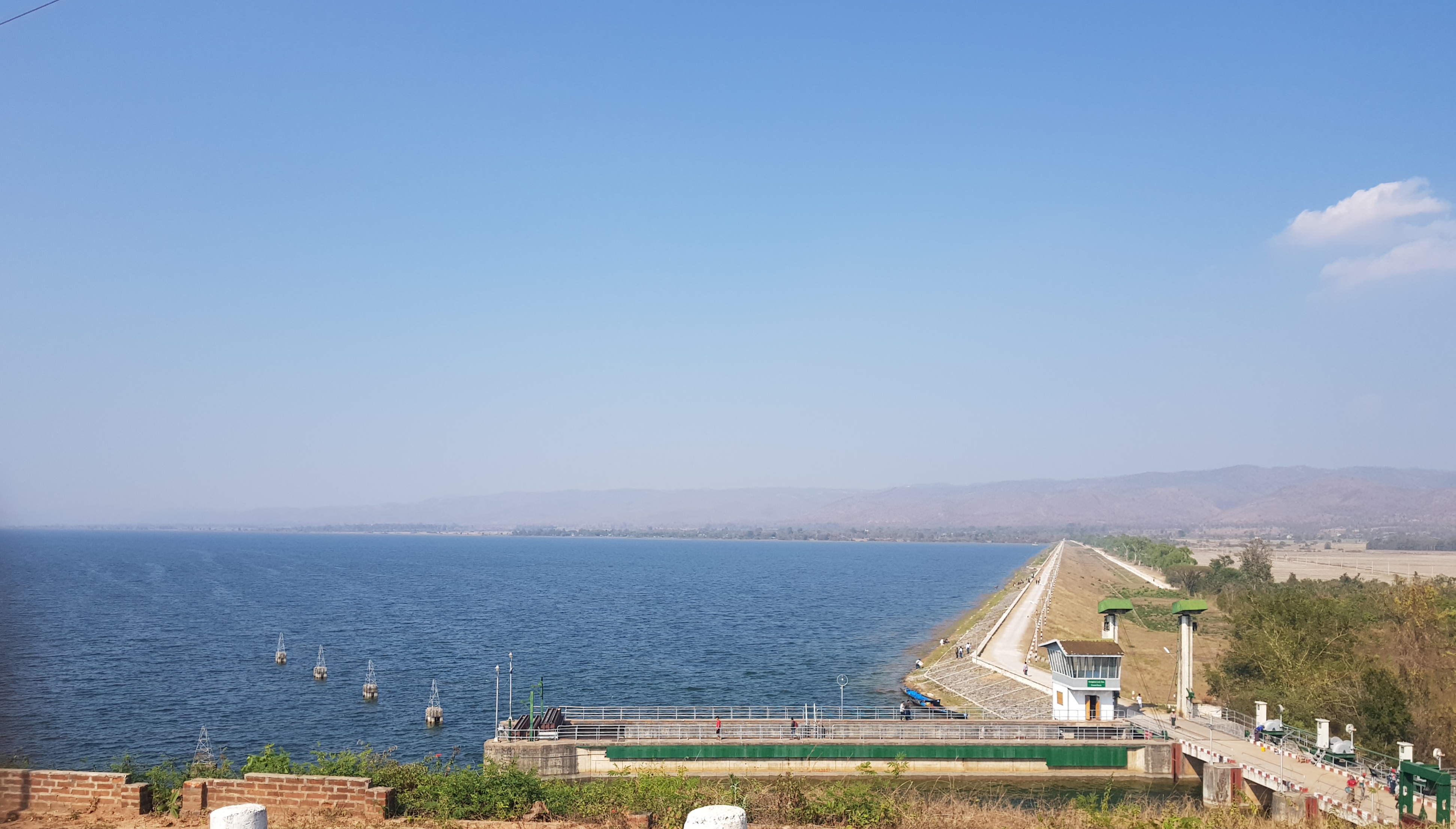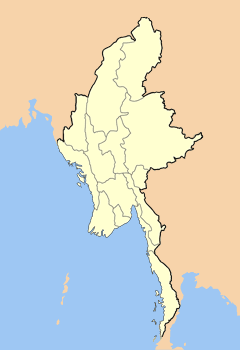|
Lower Paunglaung Dam
The Lower Paunglaung Dam is a rock-fill embankment dam on the Paunglaung River, about east of Pyinmana in Naypyidaw Union Territory, Burma. The primary purpose of the dam is hydroelectric power generation and it had been under study since 1953. Construction began in 1996 and the first generators were commissioned in 2004 and the last in 2005. Cost of the dam and power station, funded by the Chinese government, was US$201.8 million. The dam's power house is located underground near the toe and spillway. It contains four Francis turbine-generators. The Upper Paunglaung Dam, being constructed upstream, is expected to regulate the river and improved power generation. See also *Dams in Burma There are almost 200 large dams in Myanmar.CHINA IN BURMA: THE INCREASING INVESTMENT OF CHINESE MULTINATIONAL CORPORATIONS IN BURMA’S HYDROPOWER, OIL AND NATURAL GAS, AND MINING SECTOR BURMA’S HYDROPOWER OIL AND NATURAL GAS, AND MINING SECTORS ... * List of power stations in Burma Re ... [...More Info...] [...Related Items...] OR: [Wikipedia] [Google] [Baidu] |
Pyinmana
Pyinmana (, ; population: 100,000 (2006 estimate)) is a logging town and sugarcane refinery center in the Naypyidaw Union Territory of Myanmar. The administrative capital of Myanmar was officially moved to a militarized greenfield site (which the leader, Than Shwe, dubbed Naypyidaw, or Royal City) two miles (3.2 km) west of Pyinmana on November 6, 2005. As of 2014, the city has an urban population of 72,010. During World War II, Pyinmana was the base of the Burma Independence Army (later renamed and reorganized into the Burma Defence Army by the Japanese).McGirk, Jan (November 8, 2005)Burma's rulers take the road to Mandalay ''The Independent''. Climate Notable residents * Bo Let Ya Bo Htauk Htain Bo Tar Yar See also * Pyinmana Township Pyinmana Township ( my, ပျဉ်းမနားမြို့နယ်) is one of eight townships of Naypyidaw Union Territory, Myanmar. History Historically, Pyinmana was formerly known as Ningyan (နင်းကြမ်း). Sh ... [...More Info...] [...Related Items...] OR: [Wikipedia] [Google] [Baidu] |
Dams In Burma
There are almost 200 large dams in Myanmar.CHINA IN BURMA: THE INCREASING INVESTMENT OF CHINESE MULTINATIONAL CORPORATIONS IN BURMA’S HYDROPOWER, OIL AND NATURAL GAS, AND MINING SECTOR BURMA’S HYDROPOWER OIL AND NATURAL GAS, AND MINING SECTORS UPDATED: September 2008 Myanmar (Burma) has a large hydroelectric power potential of , although the economical exploitable potential is about . Between 1990 and 2002, the country tripled its installed capacity of hydro plants, increasing from to . Total installed capacity in 2010 is at least MW, 6% of potential. Several large dams are planned to increase future hydro utilization. Background Although Myanmar is underdeveloped in terms of its hydro-power potential it is not for lack of effort. While chairman of the State Peace and Development Council, Sr-Gen Than Shwe prioritized the building of dams. A native of the Kyaukse region through which the Zawgyi River flows, Shwe was widely rumored to believe himself to be a reincarnation of K ... [...More Info...] [...Related Items...] OR: [Wikipedia] [Google] [Baidu] |
Hydroelectric Power Stations In Myanmar
Hydroelectricity, or hydroelectric power, is electricity generated from hydropower (water power). Hydropower supplies one sixth of the world's electricity, almost 4500 TWh in 2020, which is more than all other renewable sources combined and also more than nuclear power. Hydropower can provide large amounts of low-carbon electricity on demand, making it a key element for creating secure and clean electricity supply systems. A hydroelectric power station that has a dam and reservoir is a flexible source, since the amount of electricity produced can be increased or decreased in seconds or minutes in response to varying electricity demand. Once a hydroelectric complex is constructed, it produces no direct waste, and almost always emits considerably less greenhouse gas than fossil fuel-powered energy plants. [...More Info...] [...Related Items...] OR: [Wikipedia] [Google] [Baidu] |
Dams In Myanmar
There are almost 200 large dams in Myanmar.CHINA IN BURMA: THE INCREASING INVESTMENT OF CHINESE MULTINATIONAL CORPORATIONS IN BURMA’S HYDROPOWER, OIL AND NATURAL GAS, AND MINING SECTOR BURMA’S HYDROPOWER OIL AND NATURAL GAS, AND MINING SECTORS UPDATED: September 2008 Myanmar (Burma) has a large hydroelectric power potential of , although the economical exploitable potential is about . Between 1990 and 2002, the country tripled its installed capacity of hydro plants, increasing from to . Total installed capacity in 2010 is at least MW, 6% of potential. Several large dams are planned to increase future hydro utilization. Background Although Myanmar is underdeveloped in terms of its hydro-power potential it is not for lack of effort. While chairman of the State Peace and Development Council, Sr-Gen Than Shwe prioritized the building of dams. A native of the Kyaukse region through which the Zawgyi River flows, Shwe was widely rumored to believe himself to be a reincarnation of K ... [...More Info...] [...Related Items...] OR: [Wikipedia] [Google] [Baidu] |
Energy Infrastructure Completed In 2005
In physics, energy (from Ancient Greek: ἐνέργεια, ''enérgeia'', “activity”) is the quantitative property that is transferred to a body or to a physical system, recognizable in the performance of work and in the form of heat and light. Energy is a conserved quantity—the law of conservation of energy states that energy can be converted in form, but not created or destroyed. The unit of measurement for energy in the International System of Units (SI) is the joule (J). Common forms of energy include the kinetic energy of a moving object, the potential energy stored by an object (for instance due to its position in a field), the elastic energy stored in a solid object, chemical energy associated with chemical reactions, the radiant energy carried by electromagnetic radiation, and the internal energy contained within a thermodynamic system. All living organisms constantly take in and release energy. Due to mass–energy equivalence, any object that has mass when ... [...More Info...] [...Related Items...] OR: [Wikipedia] [Google] [Baidu] |
Energy Infrastructure Completed In 2004
In physics, energy (from Ancient Greek: ἐνέργεια, ''enérgeia'', “activity”) is the quantitative property that is transferred to a body or to a physical system, recognizable in the performance of work and in the form of heat and light. Energy is a conserved quantity—the law of conservation of energy states that energy can be converted in form, but not created or destroyed. The unit of measurement for energy in the International System of Units (SI) is the joule (J). Common forms of energy include the kinetic energy of a moving object, the potential energy stored by an object (for instance due to its position in a field), the elastic energy stored in a solid object, chemical energy associated with chemical reactions, the radiant energy carried by electromagnetic radiation, and the internal energy contained within a thermodynamic system. All living organisms constantly take in and release energy. Due to mass–energy equivalence, any object that ha ... [...More Info...] [...Related Items...] OR: [Wikipedia] [Google] [Baidu] |
Dams Completed In 2005
A dam is a barrier that stops or restricts the flow of surface water or underground streams. Reservoirs created by dams not only suppress floods but also provide water for activities such as irrigation, tap water, human consumption, Industrial water, industrial use, aquaculture, and navigability. Hydropower is often used in conjunction with dams to generate electricity. A dam can also be used to collect or store water which can be evenly distributed between locations. Dams generally serve the primary purpose of retaining water, while other structures such as floodgates or levees (also known as Dike (construction), dikes) are used to manage or prevent water flow into specific land regions. The earliest known dam is the Jawa Dam (Jordan), Jawa Dam in Jordan, dating to 3,000 BC. The word ''dam'' can be traced back to Middle English, and before that, from Middle Dutch, as seen in the names of many old cities, such as Amsterdam and Rotterdam. History Ancient dams Early dam build ... [...More Info...] [...Related Items...] OR: [Wikipedia] [Google] [Baidu] |
List Of Power Stations In Burma
The following is a list of the power stations in Myanmar. Coal Gas Hydroelectric See also *Energy in Myanmar * List of largest power stations in the world References {{DEFAULTSORT:Power stations in Myanmar Myanmar Myanmar, ; UK pronunciations: US pronunciations incl. . Note: Wikipedia's IPA conventions require indicating /r/ even in British English although only some British English speakers pronounce r at the end of syllables. As John C. Wells, Joh ... Economy of Myanmar-related lists Power stations in Myanmar Power stations ... [...More Info...] [...Related Items...] OR: [Wikipedia] [Google] [Baidu] |
Upper Paunglaung Dam
The Upper Paunglaung Dam is a gravity dam on the Paunglaung River, about east of Pyinmana on the border of Naypyidaw Union Territory and Shan State, Burma. The primary purpose of the dam is hydroelectric power generation, provided by the power station it supports. Preliminary construction on the dam site began in January 2005 and roller-compacted concrete placement for the dam commenced in October 2010. The dam was completed and impounded its reservoir in december 2015. It is expected to regulate the river and improve power generation at the downstream Lower Paunglaung Dam. The dam forced the relocation of some 15,000 residents which has drawn backlash from locals to international organizations.Connor Macdonald,New report highlights 'devastating human cost' of Upper Paunglaung Dam project' ''Mizzima'', 7 October 2015. Many have already relocated but complain that their new land is of an insufficient size, has no power supply or natural resources to work. AF-Consult Switzerlan ... [...More Info...] [...Related Items...] OR: [Wikipedia] [Google] [Baidu] |




.jpg)
